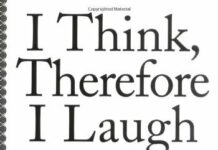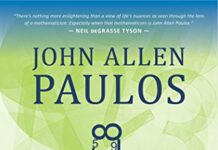
Ebook Info
- Published: 2008
- Number of pages: 126 pages
- Format: PDF
- File Size: 1.45 MB
- Authors: John Allen Paulos
Description
John Allen Paulos cleverly scrutinizes the mathematical structures of jokes, puns, paradoxes, spoonerisms, riddles, and other forms of humor, drawing examples from such sources as Rabelais, Shakespeare, James Beattie, René Thom, Lewis Carroll, Arthur Koestler, W. C. Fields, and Woody Allen.”Jokes, paradoxes, riddles, and the art of non-sequitur are revealed with great perception and insight in this illuminating account of the relationship between humor and mathematics.”—Joseph Williams, New York Times”‘Leave your mind alone,’ said a Thurber cartoon, and a really complete and convincing analysis of what humour is might spoil all jokes forever. This book avoids that danger. What it does. . .is describe broadly several kinds of mathematical theory and apply them to throw sidelights on how many kinds of jokes work.”—New Scientist”Many scholars nowadays write seriously about the ludicrous. Some merely manage to be dull. A few—like Paulos—are brilliant in an odd endeavor.”—Los Angeles Times Book Review
User’s Reviews
Reviews from Amazon users which were colected at the time this book was published on the website:
⭐John Allen Paulos has written a number of books on Mathematics, and “Mathematics and Humor” was his first, published originally in 1980. It is a short book, at just a little over 100 pages, and that is with plenty of drawings and graphs. I had high hopes going into it of an interesting read, but it just didn’t deliver. Paulos has some interesting thoughts and ideas, but the writing was a detriment to the communication of his points to the reader.In the introduction, Paulos looks at various definitions of humor from history, which usually involves a formula (non-mathematical formulas or ingredients for what is considered humorous). He then moves to look at some examples of mathematical proofs which are clever, and involve ingenuity, before looking at what he considers to be “a bridge between humor and mathematics” which is “brain teasers”, trick problems, riddles, etc.The next few chapters deal with looking at mathematical concepts and then looking at what types of humor fit into those categories. This includes applications of axioms and iteration, self-reference and paradox, grammar and philosophy. While some of those don’t specifically sound like mathematical concepts, Paulos does demonstrate how they do relate to mathematical areas.Paulos then introduces talks about a “Catastrophe Theory Model of Jokes and Humor”, and this is the longest chapter in the book. Paulos discusses how humor, similar to the behavior of an animal, depends on how the situation is presented to the subject. Just as a animal might respond with fear or rage, depending on the circumstances surrounding an event, a person might find something humorous depending on the same.Paulos finishes with a short wrap-up of the subject, and I think that this book is going to face its own Catastrophe Theory, in that how it is perceived by the reader is going to be based on the circumstances surrounding the event of reading it. I think it will depend largely on the background of the reader on whether they enjoy the book, or find it not very interesting. Paulos has failed to find a way to level-set the subject for the reader so that it delivers a consistent response to the book. I believe he has solved this problem, given the success of his later works.
⭐I wanted this book for two reasons–first, I read the Paulos’ best selling book, Innumeracy, and second, I like both of the subjects.Paulos begins with a brief chapter on definitions of humor by historical philosophers and writers. It’s pretty interesting–what is it that makes something funny? His second chapter uses some mathematical and logical examples to help approximate what is going on in most examples of humor.Paulos’ main thesis seems to be that the most common example of humor deals with setting up the unexpected incongruity. One of his examples is great. A perverted old man leers at a young virgin girl and says, “What goes in dry and hard, yet comes out soft and wet?” The girl blushes. The old man replies, “Chewing gum.” In this example, the joke implied axioms (answers to his question) which were quite different than his chewing gum answer. The greater this incongruity is, the better the punchline (which is why sexual connotations are often found funny).Other chapters discuss variations on this theme, culminating in a theory of catastrophe involving dogs and the model for whether they will fight or run away when confronted. It’s quite interesting.I really enjoyed the book, and found it to be quite thought-provoking. Paulos does a great job of explaining many tough mathematical concepts, including Gödel’s Theorem. I didn’t fully understand Thom’s Theorem at the end, but that’s okay. One thing to be aware of is that the book is short and leaves you wanting more.I think anybody interested in math will find this book entertaining, even if they’re not particularly excited by humor. I do think interest in mathematics is requisite to enjoy this book, however.
⭐I thought it was an excellent, the style is concise and the book a pleasure to read. The following are true, despite the fact that they are generally contradictory: the ideas expressed are non-trivial, the mathematics the author refers to are advanced, the exposition is clear enough (I never studied catastrophe theory), and the comparisons (humor and math) are really not far-fetched. A really enjoyable and memorable read.
⭐One thing that most people will appreciate in this book is a better understanding of their mathematics professor’s strange sense of humor. I agree with the author that most mathematicians do show a certain, recognizable style of humor. He goes on to explain the ways that mathematical reasoning resembles, and therefore illuminates humor. This book provides an entertaining introduction to mathematical concepts and theory. I’m not sure that I would recommend it as highly on the other side–to comedians. This is more of a philosopher’s approach to humor.
⭐I am by no means an expert on metaphysics but I thought it was great.
Keywords
Free Download Mathematics and Humor in PDF format
Mathematics and Humor PDF Free Download
Download Mathematics and Humor 2008 PDF Free
Mathematics and Humor 2008 PDF Free Download
Download Mathematics and Humor PDF
Free Download Ebook Mathematics and Humor



